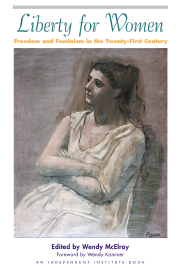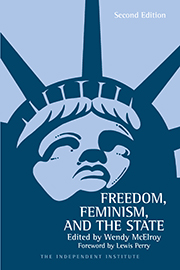The nineteenth-century phenomenon of sweatshops is re-emerging as an important 21st-century issue for American labor and business. For example, the United Students Against Sweatshops has called on its 180 campus affiliates to organize and force universities to deal only with manufacturers who abide by fair labor practices. In February, students from the University of Pennsylvania staged a much publicized sit-in in front of the president’s office to ensure that the logo apparel sold by the university was not produced by sweatshop labor.
Although the students admitted that they had no evidence that any apparel had been produced by sweatshops, they thought it was “a safe assumption.” The university agreed to withdraw from the Fair Labor Association, which students called “an industry-controlled monitoring system that only serves to cover up sweatshop abuses” and “a public-relations operation designed to improve the image of its members, like Kathie Lee Gifford and Nike.” Instead, the university agreed to join the Worker Rights Consortium—a human rights and labor organization that advocates the “rights” to a living wage and to unionize in the Third World. But labor activists quickly point out that sweatshops exist in America too. Indeed, they seem to be a growing trend. A “Garment Enforcement Report” (April-June 1999) from the U.S. Labor Department reported that 205 sweatshop investigations resulted in the discovery of 109 violations.
In the Austin American-Statesman (February 27), journalist Martha Irvine offers a typical account. Irvine begins by focusing on the harsh labor conditions of a tortilla factory on Chicago’s South Side, then goes on to report the wider findings of the Center for Impact Research. “More than a third of the 800 workers questioned—many of them immigrants—described conditions in factories, restaurants and other workplaces that the federal government would deem sweatshops.” As a result of this report and ensuing publicity, the U.S. Department of Labor announced its intention to work with ethnic community groups in order to uncover abusive employers.
This is a common pattern in anti-sweatshop activism—stories of personal exploitation are coupled with thin statistical analysis, which collectively result in a superficial governmental response. Often, the abuse is real. Sometimes, it is hideous. Unscrupulous employers are always blamed—and with cause. Government is always the proposed solution, with disastrous results.
Few people seem to question one of the fundamental reasons that nineteenth-century sweatshop conditions exist in 21st-century America. Free-market advocates correctly point out that low wages are appropriate to untrained, unskilled workers and that many of the sweatshop conditions are no more than [p. 30] what naturally occur in the lowest-paid strata of employment. But, arguably, the most important abuses—for example, an inability of employees to organize or to enforce agreements—are the result of government. In this the Immigration and Naturalization Service (INS) must bear particular responsibility. As one of the tortilla factory workers explained to Irvine, “Because they [laborers] don’t have papers, the bosses think they can do what they want.” Employees who are not authorized by government to work have little or no protection against employers who break contracts and coerce their labor through threats. Usually they threaten to turn employees or their undocumented family members in to the INS for deportation.
Papers proving a worker’s eligibility for employment became mandatory in the United States under the Immigration Reform Control Act (IRCA) of 1986. IRCA requires employers to complete an I-9 Form for “new hires” in order to record the documents that establish the worker’s employment eligibility. Immediately, undocumented workers became vulnerable to abuse. For example, if an undocumented employee protests a breach of contract, he (or members of his family) can be reported to the INS.
The relationship between undocumented workers and the big labor unions is more complicated. In 1986, the AFL-CIO vigorously backed IRCA, largely because it gives American workers an extreme advantage in the labor market. For over a decade, Big Labor watched contentedly as every employer—under threat of legal sanctions—filled out an I-9 form on every employee. Now powerful unions such as UNITE (Union of Needle- trades, Industrial and Textile Employees) call for the repeal of those sanctions. AFL-CIO Secretary Treasurer Richard Trurnka declares, “we are all illegals . . . in the eyes of Wall St.” By this statement he links the interests of American laborers with those of undocumented immigrants, both of whom are the alleged victims of exploitative capitalism. Thus Big Labor demands additional regulation to prevent sweatshops. The regulations being demanded are designed to solve problems that the unions themselves helped to create through their former support of INS policies. To understand Big Labor’s shift on undocumented workers, it is necessary to sketch some history.
Abuse Created by the INS
Requiring 1-9 forms on every new worker soon became inadequate for the government to “protect” American labor. In 1998 the agency grew tired of needing grounds for suspicion to conduct background checks on specific types of employees. Thus began an experiment called “Operation Vanguard”—a fishing expedition within the meatpacking industry of the midwest. The INS subpoenaed the employment records of all meatpacking plants in Nebraska, then cross-referenced them against Social Security and other government databases to determine which workers had proper employment authorization. After the initial industry-wide audit, the INS followed up with additional audits at regular intervals to check on new hires. (The program has since been extended to other states, with the INS proposing to hire private firms to run the relevant background checks. Such firms would not be subject to the same restraints as governmental agencies.)
When a discrepancy appeared in a document, the worker in question was ordered to appear at an INS interview. In many, if not most, cases the discrepancy was the fault of the INS. “The information on these databases is notoriously bad,” explains Josh Bernstein, senior policy analyst at the National Immigration Law Center. “And because the database is flawed, a lot of people who have employment authorization end up showing up as illegal.”
Even if they are legal, many foreign workers decide to quit their jobs rather than be interviewed by the INS. “It’s like an IRS audit, except imagine that you face the threat of going out in handcuffs,” Bernstein says. Further, many legal workers leave their jobs because a family member is not documented, and so they don’t want to undergo an interview.
Horror stories of INS abuses as well as negative memories of government in their home countries mean that many workers simply flee. Usually, they are forced to work off the books at less attractive jobs where they have no seniority and where the employer may know how much they fear the INS. For example, on May 5, 1999, INS agents arrived at an IBP meatpacking plant in Lexington, Nebraska, to question more than 2,000 workers. The INS had previously reviewed the plant’s I-9s and had found 318 discrepancies. On the date of the interviews, however, 185 of the workers under suspicion had left. Of the remaining 133, one was arrested and one was fired. The INS sweep disrupted plant operations and ter rorized hundreds of workers.
One INS tactic in particular is almost a formula for creating sweatshops. As a general part of its strategy, the INS has encouraged employers to become partners in the government’s verification process. Employers are urged to use an electronic employment program called “Basic Pilot,” a joint project of the INS and Social Security that lets employers check up on all employees by accessing government databases. Basic Pilot was first used in California, Florida, Illinois, New York, and Texas, but has been expanded.
Offering employers access to government databases is part of an INS strategy called “interior enforcement”—that is, the enforcement of immigration law away from the border. In the eyes of already fearful immigrant workers, the employer is now an arm of the INS. Indeed, workers-rights groups warn that the INS is using employers as enforcement agents. Of course, having incriminating information on an employee gives an employer a great negotiating advantage. Some unethical employers have exploited this advantage to the detriment of undocumented workers who no longer feel able to enforce contracts or complain of abuses. Workers who participate in a union can be reported to the INS. In essence, the INS has given employers a green light to create sweatshops.
Big Labor’s Shift on Undocumented Workers
At its 1999 annual convention in Los Angeles, top officials of the AFL-CIO admitted having made a mistake in backing the IRCA. But the government harassment of immigrant workers is not what provoked Big Labor into changing its stance. After all, such compassion had not prompted the AFL-CIO to advocate the protection of immigrant labor in the past. Rather, Big Labor’s concerns were twofold: First, union membership has been declining across the board for decades. In the 1950s, 35 percent of U.S. workers belonged to a union. Today, the percentage is close to 14. To hold steady at that level, unions have to recruit 400,000 workers a year. With union figures stating that one in ten workers is foreign-born, Big Labor has come to a tardy conclusion: immigrant labor needs unions.
Eliseo Medina, vice president of the Service Employees union, is more candid: the unions need immigrant labor. “I am . . . convinced that as the labor movement is the best hope for immigrants, so are immigrants the best hope of the labor movement.” If unions are to thrive into the 21 st century, they need to reconstruct their power base. Miguel Contreras, secretary of the Los Angeles County Federation of Labor, the country’s largest labor council, agrees. “If we’re going to organize LA, we have to organize immigrants.”
The second reason for Big Labor’s shift on IRCA is the upsurge in union-busting that has accompanied this measure. Especially in the area of agriculture, farm managers have called on the INS repeatedly to pick up undocumented workers who were key figures in union drives. For example, nearly 1,700 employees were fired from 13 apple-packing houses in the Yakima Valley of Washington state in March 1999. These businesses had been the targets of intense organizing by the Teamsters. By sweeping the apple-packing houses clean of workers with “discrepancies,” employers also destroyed the rank-and-file leadership of the growing union. Arturo Rodriguez, president of the United Farm Workers, claims that Bear Creek Production Company, a California rose grower, arranged to have 15 percent of the union’s members fired through an INS review of documents. “These are workers that have been here 15, 20, 25 years,” he states, “have houses, have families, are in the educational system, have paid taxes, are members of their communities. They asked them to demonstrate their status in this country. And then they were evicted and lost their jobs.”
Some employers have been more subtle. For example, when employees at a garment factory in California joined UNITE, foreign-born union members were called into the office and required to produce their documents over and over again for verification. Other workers picked up the clue. Union support declined dramatically. Ironically, the largest barrier to the AFL-CIO’s recruitment of immigrant members and the organizing of new unions is the very law it championed in 1986—IRCA. No wonder labor councils and local unions across the nation are beginning to call for repeal of those aspects of the measure that make it illegal for an undocumented worker to hold a job. Frank Hurt, president of the Bakery, Confectionary and Tobacco Workers, had been a key voice in support of IRCA. He was dismayed by the unintended consequences that followed. “Instead, they [IRCA and the INS] arm employers with additional weapons. . . . They pit worker against worker, ally against friend, driving wedges between us when we should stand united.”
On February 16, 2000, AFL-CIO executive vice president Linda Chavez-Thompson praised immigrant laborers. “Throughout our country’s history immigrants have played an important role in building democratic institutions and vibrant new communities that enrich our lives.” Then the Executive Council issued a resolution that declared, “The so-called ‘1-9’ sanctions process, which unscrupulous employers have systematically used to retaliate against workers who join together in unions, must be eliminated.” This reversed a 1985 executive council resolution that called for the imposition of 1-9 style sanctions.
Despite this cautionary lesson on how government regulation and monitoring of business harms workers, one of the remedies for sweatshops being sought by unions is more government regulation and monitoring. For example, UNITE applauded the February 7 announcement of New York City Council Speaker Peter Vallone concerning an anti-sweatshop bill he is sponsoring. The bill would prohibit the city from purchasing apparel—including uniforms for policemen—from manufacturers who do not disclose their locations and allow inspections. In some ways, Big Labor is manifesting the same knee-jerk response that Kathie Lee Gif-ford did on discovering that her Wal-Mart clothing line was being produced by sweat labor. Gifford went on a crusade to impose more laws on business. When New York Governor George Pataki signed path-breaking anti-sweatshop legislation in 1996, he stated, “In no small measure, this bill is going to be signed this afternoon because Kathie Lee Gifford and Frank Gifford made this a personal crusade.” The legislation holds liable manufacturers and retailers who knowingly purchase, ship, or deliver goods produced by sweatshops. Such legislation will do nothing more than drive labor practices further underground where abuse can flourish unseen.
In the end, it will be the marketplace—not legislation—that determines the value of labor and the working conditions laborers will accept. The prevailing economy provides an opportunity for unions if they are willing to work with and not against market forces. Unemployment is extremely low, especially in the unattractive jobs, such as sewing, meatpacking, and agriculture, to which immigrant workers tend to gravitate. What workers need right now, while their negotiating position is strong, is the ability to bargain honestly and above-board for better wages and working conditions. Government can only interfere in this process.









